Waterloo Street History
Links to histories of individual houses: 4, 42
The street’s name acknowledges the Battle of Waterloo which took place on 18th June 1815. Other local war veterans were Sir Edward Kerrison (note the Kerrison Arms Hotel which became the Hove Lawns and the Iron Duke) and James Smith who owned a greengrocer’s shop in Waterloo Street. James Ireland was landlord of the Kerrison Arms from 1832 having returned from his failed venture at the Pleasure Gardens in the 1820s.
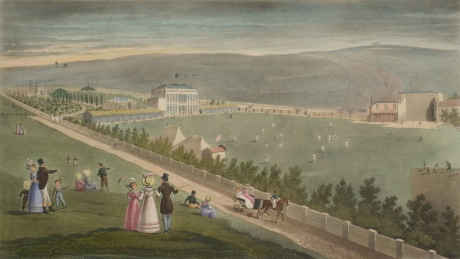
Engraving of James Irelands pleasure gardens 1820-1825
In 1841, 31 properties had been built in the street (which was re-numbered at least twice). In 1851 there were 3 small schools and 18 lodging houses. Amongst the professions of heads of households there were 10 fund-holders, 3 annuitants, a proprietor of houses, retired farmer, butler, house agent, coachman, stable keeper, dairyman, baker, greengrocer, butcher, plumber, cook, curate of Hove, dyer, landed proprietor, stonemason and at 42A Joseph Anscomb, brewer. In addition, there was an officer’s wife in the East India Company’s Bengal Civil Service, plus a surgeon in the East India Company’s Service.
The houses built in Waterloo Street, Lower and Upper Market Street were very much more modest than those in Brunswick Square and Terrace. They were intended for coachmen and others associated with stable maintenance, tradesmen and other humbler professions. However, the Street Directories and Censuses show a much greater variety of occupants. Many were long-term residents living there for several decades, while others were on a much more short-term basis. The first houses were built near the seafront.
It was Busby’s intention to make Brunswick Town self-sufficient and not depend for its existence upon Brighton, and to house coachmen, tradesmen, servants and other people required to supply the needs of the residents of the Square. Shops were not to be permitted, but instead a large market building was to be placed between Upper and Lower Market Streets and entered by an archway from Waterloo Street. This would provide stalls where the provisions required by the residents could be allowed on the south side of what is now Western Road Hove, and it was not long before they spread along the road towards what would become Palmeira Square.
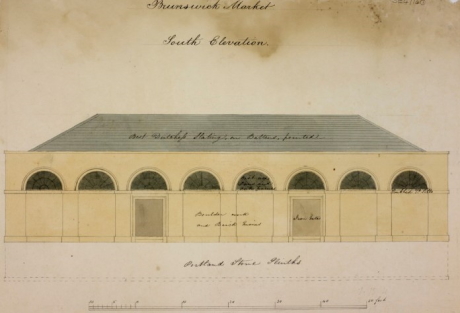
C.A. Busby’s original design for the Brunswick Market courtesy of ribapix.com
Although they were not officially allowed in the Brunswick Town area itself, the Street Directories indicate that it was not too many years before homes were being used as shops. At the same time, the market never really became successful. It is suggested that a downturn in the economy may have been the cause of the failure. It seems that Busby had made a personal investment in it and even an offer for a limited period to grant free stalls had not proved an attraction. Its life as a market was only a short one and it soon became a school and it remained that until 1839 when it became the Dupont Riding School, a much more successful establishment.
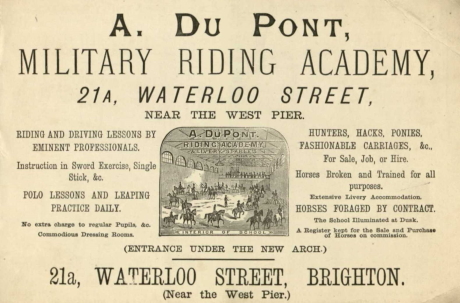
Poster advertising Du Pont’s Riding Academy
It is important to note, too, the Importance of St. Andrew’s Church, a must in any such upper-class development as Brunswick Town, though it originated as a clergyman’s private speculation, a Proprietary Chapel as the term then was. The church was designed by Charles Barry in 1827. Behind the church can be seen early examples of the use of beach pebbles as a building material.
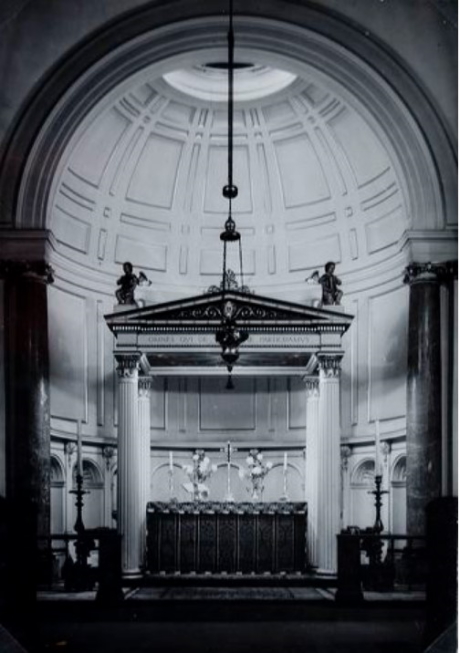
Interior of St Andrew’s from the James Gray Collection courtesy of The Regency Society
By 1861 the schools had gone but there were 12 lodging houses and 7 boarding houses (though the 1862 Directory listed 32 lodging houses). There were 62 residences and only two were unoccupied. John Howick, a plumber and painter, lived at number 36 and employed 30 men. Some houses were very overcrowded e.g., 20 people were listed at number 53. In November 1879 it was stated that six houses still drew water from their own wells. In Sept. 1881 there was a letter of complaint to the police about brawling caused by street hawkers.
In 1889 Hove Commissioners had to pay out over £57 in compensation when a horse belonging to Withers & Co. was injured because of the defective road surface at the foot of Waterloo Street. In 1900 there were complaints about the black smoke issuing from the chimneys belonging to Robins’ Brewery, which backed onto premises in Waterloo Street.
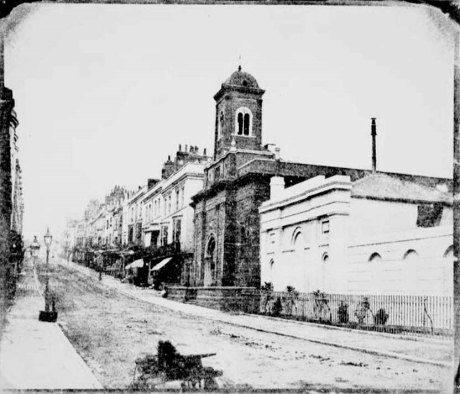
Waterloo Street c1860 from the James Gray Collection courtesy of The Regency Society
There was a Jewish community around Waterloo Street, which flourished until the 1970s and the street had a kosher butcher, a Jewish baker and a Jewish fish and chip shop, using only matzo oil. A block of four or five houses in the street were painted blue every two years (this being the national colour of Israel). Joseph Wolffe, a member of the Jewish community living in Waterloo Street attempted to swim the English Channel 22 times and the French authorities recognised his effort in 1908 with a medal.
We can see then, from the above information, the various ways in which Waterloo Street was important in providing for the various needs of Brighton residents and visitors as the town developed into a thriving resort.
Ref. Judy Middleton: ‘Hove in the Past: Waterloo Street
Research by Rosemary Pugh and Shirley Allen, 2022
If you’re interested in getting involved with our history research, or have any research that could add to this article, please contact the project leader at kevin@rth.org.uk


